Family

 My grand-niece, Raelynn Masterson, is growing up…right before our very eyes. Suddenly, Raelynn is 18 years old…an adult. Covid had an effect on Raelynn, like it did every student, except those who were exclusively online. Many students have chosen to do things differently now, and Raelynn is one of those. So, this past year, she switched from Natrona County High School (NCHS), to our third high school, Roosevelt High School, and not only does she love it, but it has been the best for her learning style. NCHS is a large school, and so there are larger classes, meaning that each student has less individual time with the teachers. The online classes showed Raelynn that the one-on-one time was important to her. NCHS also has longer class times, and alternating daily schedules, where Roosevelt uses the old method of the same daily schedule and shorter class times. Either schedule works, but Raelynn’s personal preference is the old style.
My grand-niece, Raelynn Masterson, is growing up…right before our very eyes. Suddenly, Raelynn is 18 years old…an adult. Covid had an effect on Raelynn, like it did every student, except those who were exclusively online. Many students have chosen to do things differently now, and Raelynn is one of those. So, this past year, she switched from Natrona County High School (NCHS), to our third high school, Roosevelt High School, and not only does she love it, but it has been the best for her learning style. NCHS is a large school, and so there are larger classes, meaning that each student has less individual time with the teachers. The online classes showed Raelynn that the one-on-one time was important to her. NCHS also has longer class times, and alternating daily schedules, where Roosevelt uses the old method of the same daily schedule and shorter class times. Either schedule works, but Raelynn’s personal preference is the old style.
Recently, Raelynn started a new job, her second, at Walgreens, which is where her mom, Dustie Masterson works, but not they are at opposite stores. Raelynn is at the westside and Dustie at the eastside store. Raelynn got tp work once at her mom’s store, and mid-August, Dustie is going to help out at Raelynn’s store. They get along great, so working together, even if only occasionally is a lot of fun. They both have the same sense of  humor, and they don’t get embarrassed about some of the goofy things I (and Dustie) have posted online about them. They both love to be silly, and it’s rather a no-holds-barred situation when it comes to teasing. Being a “good sport” is a must when they are teasing each other.
humor, and they don’t get embarrassed about some of the goofy things I (and Dustie) have posted online about them. They both love to be silly, and it’s rather a no-holds-barred situation when it comes to teasing. Being a “good sport” is a must when they are teasing each other.
Raelynn has not been in a hurry to learn to drive, in fact she didn’t even start to learn until this past year. She is taking it slow to make sure her really has a good handle on it. There is no sense in rushing and then immediately having your first accident. There are a few kids out there who start out driving like “an old lady,” and never really change that. I think I would rather see a prudent new driver, than one who scares everyone who is in the car with them.
Turning eighteen and graduating from high school next year, Raelynn is looking to the future. She knows that she wants to get her own apartment after high school. She already has a friend in mind to be her roommate, so that’s good. She also plans to go to college. She is a good student, and she wants it all. She has a couple of ideas on what she wants to study, but nothing that has been nailed down enough to say for sure. Nevertheless, she is planning ahead, and that makes Dustie and Rob (Raelynn’s dad and Dustie’s husband) very proud.
Planning ahead is one thing. Having the cool things you want in life is another, and while Raelynn is saving and 
 planning, she did spend that whole first check on…well, her mom doesn’t really know, but stuff she needed, apparently!! Nevertheless, once Raelynn sets a goal, nothing is going to stop her. Dustie says, “She reminds me a lot of me, but much sweeter. She must get that from her dad! This year marks her as an adult but when I look at her I still see my first little miracle (quite literally) from God. He must have known better than me what I needed in my life.” I just couldn’t have said that any better. Today Is Raelynn’s 18th birthday. Happy birthday Raelynn!! Have a great day!! We love you!!
planning, she did spend that whole first check on…well, her mom doesn’t really know, but stuff she needed, apparently!! Nevertheless, once Raelynn sets a goal, nothing is going to stop her. Dustie says, “She reminds me a lot of me, but much sweeter. She must get that from her dad! This year marks her as an adult but when I look at her I still see my first little miracle (quite literally) from God. He must have known better than me what I needed in my life.” I just couldn’t have said that any better. Today Is Raelynn’s 18th birthday. Happy birthday Raelynn!! Have a great day!! We love you!!

 Millions of people visit Niagara Falls each year. It is a beautiful sight, and one you will never forget once you’ve seen it. The boats that take you close to the bottom of the falls guarantee a “rainy” ride. It all seems so safe…right? Well, maybe not always. On July 28, 1954, a huge section of Prospect Point observation area at the brink of the American Falls, collapsed in a pie shaped section. It’s something you would never expect, and yet when you think about it, erosion can happen when you mix water and dirt or rock. Combine that with Winter’s ice, and you get expansion. Now, when you think about it, can you see how the collapse might have happened, because I certainly can?
Millions of people visit Niagara Falls each year. It is a beautiful sight, and one you will never forget once you’ve seen it. The boats that take you close to the bottom of the falls guarantee a “rainy” ride. It all seems so safe…right? Well, maybe not always. On July 28, 1954, a huge section of Prospect Point observation area at the brink of the American Falls, collapsed in a pie shaped section. It’s something you would never expect, and yet when you think about it, erosion can happen when you mix water and dirt or rock. Combine that with Winter’s ice, and you get expansion. Now, when you think about it, can you see how the collapse might have happened, because I certainly can?
The collapse, when it came sent an estimated 185,000 tons of rock thundering into the Niagara River Gorge. Park officials worried that additional sections of Prospect Point would collapse before blasting operations could begin. Following the collapse, engineers and geologists conducted surveys to determine whether blasting would be necessary to stall further rock falls into the gorge. Two sections of Prospect Point were hanging precariously over the 170 foot gorge. Officials estimated that a new fall could send an additional 50,000 tons of rock into the gorge. Engineers appeared to be at a loss as to what to do about the huge pile of rocks now at the bottom of the gorge, as well. A few have said the view from the base of the American Falls has been marred by the mass of rock now laying at the base of the falls. They weren’t even sure if the elevator to the Maid of the Mist landing at the base of the American Falls could be re-opened.
For the sake of safety, Park officials temporarily erected a fence around the collapsed area to keep the curious bystanders away. Thousands of tourists were there that day. They witnessed the huge masses of rock tumbling into the gorge. It was the worst rock fall at Niagara Falls since January 17, 1931 when a huge section of the American Falls tumbled into the gorge. Engineers from the Niagara Frontier State Parks Commission estimate the size of the rock fall as 400 feet long from the lip of the gorge…50 feet wide and 150 feet deep. This included an estimated 20 feet off the Falls crest-line crashed to a point 70 feet down the face.
After the collapse, three giant boulders were silhouetted against the red and blue mist of the Niagara Falls night display. The boulders, some as huge as houses, lay in a jumbled mess beneath the rocks from which they had fallen. Because of the mist, it was hard to see the new scar on Niagara’s face from the lower river. The north face of the American Falls, however, now introduced a raw and torn face to the Canadian side. There would necessarily be some repairs. A face lift would be needed for the new observation area according to Andrew M. Anderson, Executive Secretary and Chief Engineer for the Niagara Frontier State Parks Commission. He also indicated that the new face would be smoothed off by engineers. A new sidewalk and guard rails would be constructed once the area was proven to be safe.
The elevator shaft and tunnel to the Maid of the Mist landing below the Falls although cracked, appeared to be in no danger according to maintenance workers. Cracks in the shaft and tunnel appeared only yesterday 
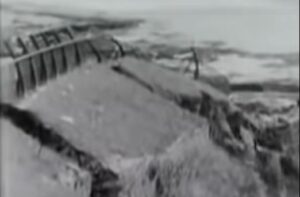 showed no signs of widening when checked last night. Water which had gushed from the crack earlier in the day had dwindled to just a trickle. Geologists examined the building that day and it reopened as soon as it was declared safe. Because so many were able to get pictures and videos of the collapse, some people even thought it was a publicity stunt.
showed no signs of widening when checked last night. Water which had gushed from the crack earlier in the day had dwindled to just a trickle. Geologists examined the building that day and it reopened as soon as it was declared safe. Because so many were able to get pictures and videos of the collapse, some people even thought it was a publicity stunt.
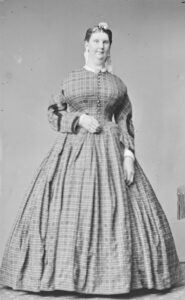
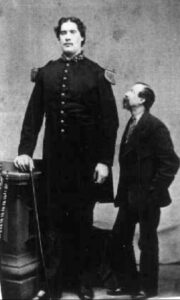 Whether you prefer tall people or short people, you can’t help but be interested in the very tall or the very short. When I think of tall, I think of over 6’5”, but some people think of someone over 7’ tall. I suppose many people think that’s not so tall, but when you’re 5’2” tall, 6’5” seems very tall, and 7’ is a giant. The tallest person in recorded history was Robert Pershing Wadlow, also known as the Alton Giant and the Giant of Illinois. He was an American man who was irrefutably the tallest person in recorded history, and of that there is irrefutable evidence. He was born and raised in Alton, Illinois, a small city near Saint Louis, Missouri. Nevertheless, he did not marry the tallest woman. The tallest married couple ever recorded was Anna Haining Swan, who was 7’11” tall and Martin Van Buren Bates, who was 7’9” tall. The pictures of their wedding show people attending the wedding, who were probably quite tall, but they looked very short next to the Bates couple.
Whether you prefer tall people or short people, you can’t help but be interested in the very tall or the very short. When I think of tall, I think of over 6’5”, but some people think of someone over 7’ tall. I suppose many people think that’s not so tall, but when you’re 5’2” tall, 6’5” seems very tall, and 7’ is a giant. The tallest person in recorded history was Robert Pershing Wadlow, also known as the Alton Giant and the Giant of Illinois. He was an American man who was irrefutably the tallest person in recorded history, and of that there is irrefutable evidence. He was born and raised in Alton, Illinois, a small city near Saint Louis, Missouri. Nevertheless, he did not marry the tallest woman. The tallest married couple ever recorded was Anna Haining Swan, who was 7’11” tall and Martin Van Buren Bates, who was 7’9” tall. The pictures of their wedding show people attending the wedding, who were probably quite tall, but they looked very short next to the Bates couple.
It is believed that Anna Swan was born at Mill Brook, New Annan, Nova Scotia. At birth she weighed 16 pounds, which is a large baby. She was the third of 13 children, but all of the others were average height. Anna grew quite quickly, reaching 4’6″ by her fourth birthday. On her 6th birthday Anna was measured again. She stood 5′ 2″ tall, just an inch or two shorter than her mother. She stood 6′ 2″ tall and weighed 203 pounds on her 11th birthday. By her 15th birthday Bates was 7′ tall. She reached her full height of 7’11” three years later. Her feet measured 14.2 inches long.
Martin Van Buren Bates was born on November 9, 1837, and was known as the “Kentucky Giant.” By the time he as full grown, he was 7’9″ and weighing 380 pounds. Bates’ growth rate didn’t jump until the age of six or seven, but he was over 6′ tall and weighed over 200 pounds by the time he was twelve years old. He served in the Civil War, and returned to Kentucky after the war. Before the war, his first occupation was as a schoolteacher, but upon his return, he began travelling with a circus. When the circus was in Halifax Martin Van Buren Bates met another enormously tall person…Anna Swan. She was attending the circus, and was spotted by the management and hired on the spot. The giant couple became a touring sensation and eventually fell in love. They married on June 17, 1871, in Saint Martin-in-the-Fields in London, in a highly publicized wedding. The ceremony drew thousands of people, due to both the uncommonness of the spectacle and the good nature of the pair. Queen Victoria gave them two extra-large diamond-studded gold watches as wedding presents.
Martin and Anna moved to Ohio in 1872, settling in Seville. On May 19, 1872, Anna gave birth to a daughter, who weighed 18 pounds. She died at birth. The couple built a large house to accommodate themselves comfortably. Martin wanted to be a farmer. The family did well, but not in the area of children. A baby boy was 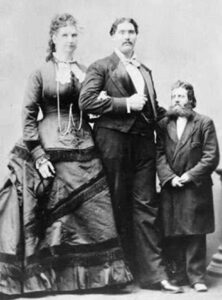
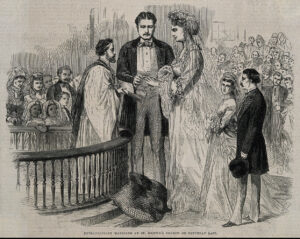 born on January 15, 1879. He weighed 23 pounds 9 ounces, and was 28′ long. He was posthumously awarded the world record according to the Guinness Book of World Records. Their son only lived 11 hours. Anna Bates died on August 5, 1888. Martin ordered a statue of her from Europe for her grave, sold the oversized house, and moved into the town. In 1889 he remarried, this time to a woman of normal stature, Annette LaVonne Weatherby and lived a mostly peaceful life until his death in 1919 of nephritis. He was buried beside his first wife and their son in Seville.
born on January 15, 1879. He weighed 23 pounds 9 ounces, and was 28′ long. He was posthumously awarded the world record according to the Guinness Book of World Records. Their son only lived 11 hours. Anna Bates died on August 5, 1888. Martin ordered a statue of her from Europe for her grave, sold the oversized house, and moved into the town. In 1889 he remarried, this time to a woman of normal stature, Annette LaVonne Weatherby and lived a mostly peaceful life until his death in 1919 of nephritis. He was buried beside his first wife and their son in Seville.
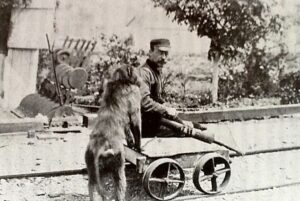 James Edwin Wide had lost both his legs in a work accident years earlier, and so in 1880, when he came across a Chacma Baboon driving an oxcart while visiting a busy South African market, he saw a way to make his life easier. Wide was impressed with the skills, and so he decided to buy him. Having two peg-legs and working had been very difficult on Wide over the years, and finally he saw an end to years of hardship. Impressed by the primate’s skills, Wide bought him, named him Jack, and made him his pet and personal assistant. His original plan was to have Jack drive him on his half-mile commute to the train station. So the first thing he trained the Jack to do was push him to and from work in a small trolley. Soon, Jack was also helping with household chores, sweeping floors and taking out the trash. Jack was very good at his work, and he truly loved Wide, almost as if Wide was his child.
James Edwin Wide had lost both his legs in a work accident years earlier, and so in 1880, when he came across a Chacma Baboon driving an oxcart while visiting a busy South African market, he saw a way to make his life easier. Wide was impressed with the skills, and so he decided to buy him. Having two peg-legs and working had been very difficult on Wide over the years, and finally he saw an end to years of hardship. Impressed by the primate’s skills, Wide bought him, named him Jack, and made him his pet and personal assistant. His original plan was to have Jack drive him on his half-mile commute to the train station. So the first thing he trained the Jack to do was push him to and from work in a small trolley. Soon, Jack was also helping with household chores, sweeping floors and taking out the trash. Jack was very good at his work, and he truly loved Wide, almost as if Wide was his child.
While Jack was very good at his caregiving job, it was at the signal box Jack truly shined. The signal box was a system of manual switches operated in connection with the approaching trains whistles. As trains approached the 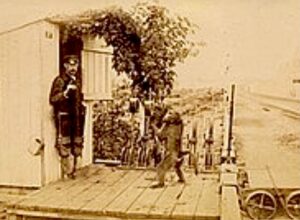 rail switches at the Uitenhage train station, they would toot their whistle a specific number of times to alert the signalman which tracks to change. By watching his owner, Jack picked up the pattern and started tugging on the levers himself. Jack was so smart. He was able to totally take over the signalman’s job that had been held by Wide. Soon, Wide was able to kick back and relax as his furry helper did all of the work switching the rails. According to The Railway Signal, Wide “trained the baboon to such perfection that he was able to sit in his cabin stuffing birds, etc, while the animal, which was chained up outside, pulled all the levers and points.”
rail switches at the Uitenhage train station, they would toot their whistle a specific number of times to alert the signalman which tracks to change. By watching his owner, Jack picked up the pattern and started tugging on the levers himself. Jack was so smart. He was able to totally take over the signalman’s job that had been held by Wide. Soon, Wide was able to kick back and relax as his furry helper did all of the work switching the rails. According to The Railway Signal, Wide “trained the baboon to such perfection that he was able to sit in his cabin stuffing birds, etc, while the animal, which was chained up outside, pulled all the levers and points.”
One day, as the story goes, an upper-class train passenger, looked out the window of the train and saw that a baboon, and not a human, was manning the gears. Of course, this brought outrage, and a complaint to the railway authorities. The authorities decided not to act in haste and fire Wide, decided to resolve the complaint by testing the baboon’s abilities. The result of that test was a group of astounded officials. “Jack knows the signal whistle as well as I do, also every one of the levers,” wrote railway superintendent George B Howe, who visited the baboon sometime around 1890. “It was very touching to see 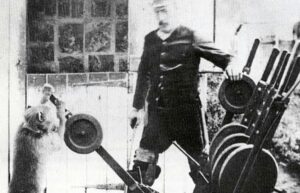 his fondness for his master. As I drew near they were both sitting on the trolley. The baboon’s arms round his master’s neck, the other stroking Wide’s face.”
his fondness for his master. As I drew near they were both sitting on the trolley. The baboon’s arms round his master’s neck, the other stroking Wide’s face.”
The complaint was disregarded and Jack was reportedly given an official employment number, and was paid 20 cents a day and half a bottle of beer weekly. Jack passed away in 1890, after developing tuberculosis. It was a sad day for all who knew him. Jack had worked the rails for nine years, without ever making a mistake. That shows that animals can be trained to do things in a responsible way, and do their job perfectly.

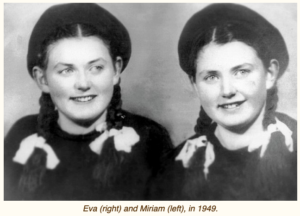 Approximately 3,000 twins were pulled from the masses on the ramp at Auschwitz, most of them were children; only around 160 of them survived. As the trains rolled into Auschwitz, the guards were trained to watch closely. They were looking for strong workers, the elderly, and the weak, and they were looking for twins…especially identical twins. The parents of these twins were thankful that they had twins…at first. They seemed to know that their twins would not be sent to the gas chambers, but they did not know that they would be taken away from them forever, and that they would be sentenced to a life of torture in the hands of a madman. The Nazis didn’t care about the feelings of the parents whose twins were yanked from their arms. They knew that Dr Josef Mengele wanted these twins for his medical experiments. Mengele wanted to find a way to cause more twin births to increase the Nazi world population. He also wanted to find a way to manipulate the traits twins had so that if they were blonde haired, a trait that supposedly meant that they were half Aryan. That said, he wanted to bring any problematic areas into line, such as the lack of blue eyes. He would inject chemicals into their eyes to try to turn their eyes blue. And that was just part of his insanely sadistic experimentation.
Approximately 3,000 twins were pulled from the masses on the ramp at Auschwitz, most of them were children; only around 160 of them survived. As the trains rolled into Auschwitz, the guards were trained to watch closely. They were looking for strong workers, the elderly, and the weak, and they were looking for twins…especially identical twins. The parents of these twins were thankful that they had twins…at first. They seemed to know that their twins would not be sent to the gas chambers, but they did not know that they would be taken away from them forever, and that they would be sentenced to a life of torture in the hands of a madman. The Nazis didn’t care about the feelings of the parents whose twins were yanked from their arms. They knew that Dr Josef Mengele wanted these twins for his medical experiments. Mengele wanted to find a way to cause more twin births to increase the Nazi world population. He also wanted to find a way to manipulate the traits twins had so that if they were blonde haired, a trait that supposedly meant that they were half Aryan. That said, he wanted to bring any problematic areas into line, such as the lack of blue eyes. He would inject chemicals into their eyes to try to turn their eyes blue. And that was just part of his insanely sadistic experimentation.
Ten-year-old Eva (Mozes) Kor and her twin sister, Miriam (Mozes) Zeiger, were one of these surviving sets of twins. The twins were born on January 31, 1934 into a Jewish farming family in the village of Portz in northern Transylvania, which was a part of Romania at the time, but later became a part of Hungary, which came under German military occupation in late World War II. Their family was deported to Auschwitz in late 1944, a fact which probably was to their advantage, because they were at Auschwitz for a shorted time that some survivors. The twins father, Alexander; their mother, Jaffa; and sisters, Edit and Aliz; all died at Auschwitz.
Eva and Miriam spent nine months in the clutches of Dr Mengele, during which time he would inject them with mystery cocktails of germs, viruses, and chemicals…just to see how they would react. Following one such injection, Miriam’s kidneys stopped growing. They remained the size of a child’s for the rest of her life. Eva recalls that after one injection, she became very ill, with a high fever. During her illness, she kept telling herself that she must survive, or else Miriam would become “surplus to requirements,” meaning that she would be given a lethal injection of something so that dual autopsies could be performed on them. Mengele wanted to see any differences the twins might have. The girls were determined that they would survive for each other.
Dr Mengele who has killed about 1,500 pairs of twins in two years, was known to perform horrible surgeries on twins, without anesthesia. One day the girls saw a set of twins brought into the barracks after surgery. The twins had been connected at their backs. Their organs had been interconnected. They were in horrible pain, and they died a short time later. While the “Mengele Twins” were given “special privileges” in some ways, better clothes and food, they were not spared the horrors of death. They saw it all around them, and they had no one to comfort them after they witnessed these horrors.
Then it happened…on January 27, 1945, while Eva and Miriam are lying in their bunks, the girls heard shouts of 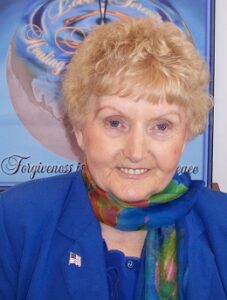
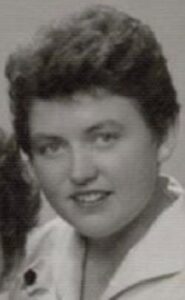 “We’re free! We’re free!” They ran to the door of the barracks, but couldn’t see anything for a few minutes because of the snow. Then they saw the Soviet soldiers in white camouflage. It was a wonderful day for them. The girls immigrated to Israel and lived in a Kibbutz that had been set up for children orphaned by the Holocaust. The grew up and both married, but only Eva had children. Miriam passed away on June 6, 1993. Eva went on to forgive the Nazis for the atrocities against the Jews. She not only forgave them, but she took young people on annual tours of the Auschwitz complex, because she didn’t want people to forget what happened there. She actually passed away while on one of those tours on July 4, 2019. These were amazing women. Would that we could all forgive in such a manner.
“We’re free! We’re free!” They ran to the door of the barracks, but couldn’t see anything for a few minutes because of the snow. Then they saw the Soviet soldiers in white camouflage. It was a wonderful day for them. The girls immigrated to Israel and lived in a Kibbutz that had been set up for children orphaned by the Holocaust. The grew up and both married, but only Eva had children. Miriam passed away on June 6, 1993. Eva went on to forgive the Nazis for the atrocities against the Jews. She not only forgave them, but she took young people on annual tours of the Auschwitz complex, because she didn’t want people to forget what happened there. She actually passed away while on one of those tours on July 4, 2019. These were amazing women. Would that we could all forgive in such a manner.

 The other day, while in the Black Hills, I was spending time in one of my favorite pastimes…people watching. Keystone, South Dakota is an interesting mix of people, and somehow everyone gets along and mingles with ease. There is no animosity in Keystone. Everyone is in a relaxed, party mood and even when they are waiting in line to order food, and the line is really long, and things are taking some time, nobody gets upset. They are kind to each other and they are patient. I watched people from all walks of life. There were bikers standing next to what appeared to me to be a doctor and his family, and there were smiles all around. People helped those who needed help, opened doors for each other; and by the way, color made no difference. In the year following a year of riots, unrest, racism, and rudeness, this was Heaven.
The other day, while in the Black Hills, I was spending time in one of my favorite pastimes…people watching. Keystone, South Dakota is an interesting mix of people, and somehow everyone gets along and mingles with ease. There is no animosity in Keystone. Everyone is in a relaxed, party mood and even when they are waiting in line to order food, and the line is really long, and things are taking some time, nobody gets upset. They are kind to each other and they are patient. I watched people from all walks of life. There were bikers standing next to what appeared to me to be a doctor and his family, and there were smiles all around. People helped those who needed help, opened doors for each other; and by the way, color made no difference. In the year following a year of riots, unrest, racism, and rudeness, this was Heaven.
Of course, we were in South Dakota…a Republican state that did not close down for Covid. I’m not going to get too deeply into politics here, but it is impossible not to notice the difference in the states. I was in Keystone when President Trump was at Rushmore, and there were protests, but no real violence, no riots, and no vandalism. People were just different there…more polite, more civil, more caring. Even in the midst of a protest, when people were calling out their own views, there was no violence. That means something. It means that people can disagree without being hateful. It also means that certain things were not going to be tolerated, and those who would act out should know they would be arrested. Of course, the police were everywhere, and having a police presence is crucial to keeping order. I am aware that there are good cops and bad cops, but in Keystone, it seemed that the police officers were good and caring, because they wanted the honor that went with being good cops.
There are also good people and bad people, and there are those who are paid to be evil. And those are the worst kind of all. People talk about the naivete of the rural people of our country, but I think they are some of 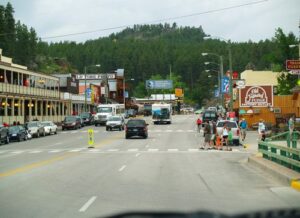
 the best people there are. Those good old fashioned values, caring about your neighbors, helping others, and not looking at the color of someone’s skin, those are the kind of people I see in rural America. I wouldn’t want to live in a big city, because I think you lose a lot of that loving, caring lifestyle. That is what we need to work toward getting back in this country…a more caring lifestyle.
the best people there are. Those good old fashioned values, caring about your neighbors, helping others, and not looking at the color of someone’s skin, those are the kind of people I see in rural America. I wouldn’t want to live in a big city, because I think you lose a lot of that loving, caring lifestyle. That is what we need to work toward getting back in this country…a more caring lifestyle.
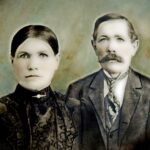
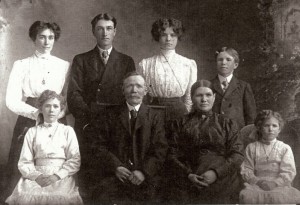 My great grandparents, Carl and Henriette (Hensel) Schumacher were farmers, first in Minnesota and then in North Dakota, where they owned land in the famous Red River Valley. I had heard of the Red River Valley as a child, but only from the old song that bears it’s name. Recently, while preparing for a trip with three of my sisters; Cheryl Masterson, Caryl Reed, and Alena Stevens; to Wisconsin and deciding to go through Fargo, North Dakota to visit our great grandparents’ graves, I was reading through my great aunt Bertha (Schumacher) Hallgren’s journal to get more information, when I came across the fact that my great grandparents had actually lived in the Red River Valley when they moved to Fargo, North Dakota. For a farmer, to live in such a fertile area and not be able to farm the land must have been just awful.
My great grandparents, Carl and Henriette (Hensel) Schumacher were farmers, first in Minnesota and then in North Dakota, where they owned land in the famous Red River Valley. I had heard of the Red River Valley as a child, but only from the old song that bears it’s name. Recently, while preparing for a trip with three of my sisters; Cheryl Masterson, Caryl Reed, and Alena Stevens; to Wisconsin and deciding to go through Fargo, North Dakota to visit our great grandparents’ graves, I was reading through my great aunt Bertha (Schumacher) Hallgren’s journal to get more information, when I came across the fact that my great grandparents had actually lived in the Red River Valley when they moved to Fargo, North Dakota. For a farmer, to live in such a fertile area and not be able to farm the land must have been just awful.
They had farmed in the Lisbon, North Dakota area. Later they moved to Fargo, when Great Grandma became ill, and the family left the farm for good. For my great aunts, Mina (Schumacher) Spare and Elsa (Schumacher) Lawrence, the move to Fargo was a welcomed one. They never really loved the farming lifestyle, and they saw the move to Fargo as a definite “step up” in the world. For Bertha and Great Grandpa, it was one of the saddest moments in their lives. They loved the outdoors, farming, and especially the Red River Valley’s fertile ground. They would take walks in the spring, summer, and fall, walking two to three miles to the edge of town to look out on the fields of crops that grew in the Red River Valley. They always wished they could go back to farming, but Grandma needed to be in town and closer to medical care. It wasn’t just this illness that plagued her, but the fact that the last nineteen years of her life were spent in a wheelchair, that made the need for closeness to doctors and hospitals so important.
My guess is that both Great Grandpa and Great Aunt Bertha hoped that someday they might be able to move to the farmland of the Red River Valley, but I expect that they knew deep down inside that it was not to be. Great Grandpa was getting on in years, and grandma was never going to get well enough to move back to the country. The wheelchair was extremely limiting. Sadly, there was a medicine that came from Germany that was helping 
 Great Grandma, but it became unavailable during World War I, so the doctor did other drastic treatments…electric shock treatments and drawing up the cords in her knees, which rendered her wheelchair bound for the rest of her life. For Great Grandpa and Great Aunt Bertha, they were thankful that they could walk out to the edge of town and see the Red River Valley, but always sad that they could not walk those crop fields and dig in the fertile dirt there. They would always miss farming.
Great Grandma, but it became unavailable during World War I, so the doctor did other drastic treatments…electric shock treatments and drawing up the cords in her knees, which rendered her wheelchair bound for the rest of her life. For Great Grandpa and Great Aunt Bertha, they were thankful that they could walk out to the edge of town and see the Red River Valley, but always sad that they could not walk those crop fields and dig in the fertile dirt there. They would always miss farming.
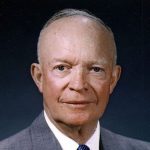 Some nations really can’t be trusted with weapons of mass destruction. They are eager to start a war, and they don’t have the moral scruples necessary to care about the loss of life involved. When nuclear weapons began to be produced, nations like the Soviet Union, China, Germany, Iran, Iraq, and various others, simply couldn’t be trusted with these weapons, but it was difficult to stop them from developing them, just like it is today. Therefore, nations have had to develop ways to restrict the usage of these weapons.
Some nations really can’t be trusted with weapons of mass destruction. They are eager to start a war, and they don’t have the moral scruples necessary to care about the loss of life involved. When nuclear weapons began to be produced, nations like the Soviet Union, China, Germany, Iran, Iraq, and various others, simply couldn’t be trusted with these weapons, but it was difficult to stop them from developing them, just like it is today. Therefore, nations have had to develop ways to restrict the usage of these weapons.
On July 21, 1955, President Dwight D Eisenhower presented his “Open Skies” plan at the 1955 Geneva summit meeting with Prime Minister Anthony Eden of Great Britain, Premier Edgar Faure of France, and Premier Nikolai Bulganin of the Soviet Union…acting for Soviet leader Nikita Khrushchev, in Geneva in July 1955, to present the plan. The plan was never accepted, but it laid the foundation for President Ronald Reagan’s “Trust, But Verify” policy in relation to arms agreements with the Soviet Union. The planned agenda for the summit included discussions on the future of Germany and arms control, but as it became clear that no agreement could be  reached on the issue of possible German reunification or the precise configuration of an arms control agreement, considering what had happened in Germany after World War I, Eisenhower dramatically unveiled what came to be known as his “Open Skies” proposal. The proposal called for the United States and the Soviet Union to exchange maps indicating the exact location of every military installation in their respective nations. The purpose of the maps was to allow each nation to conduct aerial surveillance of the installations in order to assure that the other nations were in compliance with any arms control agreements that might be reached. While it sounded like a good idea, it had little chance of acceptance. The French and British expressed interest in the idea, but the Soviets rejected any plan that would leave their nation subject to surveillance by a Western power. Khrushchev declared that Eisenhower’s “Open Skies” was nothing more than an “espionage plot.”
reached on the issue of possible German reunification or the precise configuration of an arms control agreement, considering what had happened in Germany after World War I, Eisenhower dramatically unveiled what came to be known as his “Open Skies” proposal. The proposal called for the United States and the Soviet Union to exchange maps indicating the exact location of every military installation in their respective nations. The purpose of the maps was to allow each nation to conduct aerial surveillance of the installations in order to assure that the other nations were in compliance with any arms control agreements that might be reached. While it sounded like a good idea, it had little chance of acceptance. The French and British expressed interest in the idea, but the Soviets rejected any plan that would leave their nation subject to surveillance by a Western power. Khrushchev declared that Eisenhower’s “Open Skies” was nothing more than an “espionage plot.”
The truth is that “Open Skies” was definitely not an “espionage plot,” but then we all knew that. Eisenhower was later quoted as saying that he knew “the Soviets would never accept the plan, but thought that their rejection of the idea would make the Russians look like they were the major impediment to an arms control  agreement.” The problem the Soviets had was that US surveillance planes would quickly find out that the Soviet Union was far behind the United States in terms of its military capabilities. The United States soon found that out anyway, because just a few months after the Soviet rejection of “Open Skies,” the Eisenhower administration approved the use of high-altitude spy planes (the famous U-2s) for spying on the Soviet Union. Thirty years later, President Reagan would use much the same rhetoric in his arms control dealings with the Soviet Union. Arms control, he declared, could only be effective if compliance with such agreements could be verified. “Trust, but verify” became Reagan’s standard phrase, and the truth is they were both right. If these rogue nations can’t be held accountable, they will continue to develop weapons of mass destruction, even while they are in a supposed agreement not to.
agreement.” The problem the Soviets had was that US surveillance planes would quickly find out that the Soviet Union was far behind the United States in terms of its military capabilities. The United States soon found that out anyway, because just a few months after the Soviet rejection of “Open Skies,” the Eisenhower administration approved the use of high-altitude spy planes (the famous U-2s) for spying on the Soviet Union. Thirty years later, President Reagan would use much the same rhetoric in his arms control dealings with the Soviet Union. Arms control, he declared, could only be effective if compliance with such agreements could be verified. “Trust, but verify” became Reagan’s standard phrase, and the truth is they were both right. If these rogue nations can’t be held accountable, they will continue to develop weapons of mass destruction, even while they are in a supposed agreement not to.

 My grand-niece, Katy Balcerzak’s fiancé, Dylan Herr is co-owner, with his dad, Robert Herr, of Red Wing Shoes. They have stores in Casper, Wyoming; Cheyenne, Wyoming; and Brighton, Colorado. Recently Dylan, Katy, and their precious son, Max moved from Brighton to Casper to run the new store here. The only bad thing about that is that, at least for now, Dylan is working 7 days a week, and periodically traveling to Cheyenne and Brighton to check on things there. The Herr family has owned a Red Wing Shoe Stores franchise for three generations. They continue to expand and grow in sales.
My grand-niece, Katy Balcerzak’s fiancé, Dylan Herr is co-owner, with his dad, Robert Herr, of Red Wing Shoes. They have stores in Casper, Wyoming; Cheyenne, Wyoming; and Brighton, Colorado. Recently Dylan, Katy, and their precious son, Max moved from Brighton to Casper to run the new store here. The only bad thing about that is that, at least for now, Dylan is working 7 days a week, and periodically traveling to Cheyenne and Brighton to check on things there. The Herr family has owned a Red Wing Shoe Stores franchise for three generations. They continue to expand and grow in sales.
Dylan and Katy recently bought their first house here in Casper, and he has become quite the handyman. He put together a swing set for Max, which as we all know, is not the easiest of projects. He has also completely transformed the 
 yard at the house, which needed a lot of work to take it from dead weeds to green grass. Being a homeowner is, as most of us know or find out quickly, a rather large and never ending job. Houses, while wonderful to have, are always in need of some kind of work. Dylan seems to have a knack for that kind of thing, so I’m sure those little projects are really rather fun. It’s always exciting to put your own stamp on your new home, and to show your unique style. Dylan and Katy have been doing just that since they moved back to Casper.
yard at the house, which needed a lot of work to take it from dead weeds to green grass. Being a homeowner is, as most of us know or find out quickly, a rather large and never ending job. Houses, while wonderful to have, are always in need of some kind of work. Dylan seems to have a knack for that kind of thing, so I’m sure those little projects are really rather fun. It’s always exciting to put your own stamp on your new home, and to show your unique style. Dylan and Katy have been doing just that since they moved back to Casper.
Dylan is a very patient and kind person. That is truly what made Katy love him so, and why Max thinks he is 
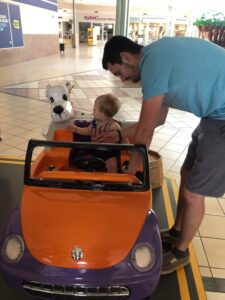 the greatest daddy on Earth. Having moved to Casper, Dylan misses his parents, Robert and Dee Dee Herr, and his brother Tyler Herr and his wife, Amber, and they miss him, Katy, and Max very much. They are all a close family, including the grandparents, and that makes a move hard. It’s always hard to live far from your kids…especially when the grandchildren begin to show up. Dylan’s parent and brother are all very close to Dylan’s little family, and it makes it hard, but thankfully it isn’t too far away. they can get up for weekends and such once in a while, and that helps a lot. Dylan and Katy are starting this new adventure in her home town, and we are very happy for them. Today is Dylan’s birthday. Happy birthday Dylan!! Have a great day!! We love you!!
the greatest daddy on Earth. Having moved to Casper, Dylan misses his parents, Robert and Dee Dee Herr, and his brother Tyler Herr and his wife, Amber, and they miss him, Katy, and Max very much. They are all a close family, including the grandparents, and that makes a move hard. It’s always hard to live far from your kids…especially when the grandchildren begin to show up. Dylan’s parent and brother are all very close to Dylan’s little family, and it makes it hard, but thankfully it isn’t too far away. they can get up for weekends and such once in a while, and that helps a lot. Dylan and Katy are starting this new adventure in her home town, and we are very happy for them. Today is Dylan’s birthday. Happy birthday Dylan!! Have a great day!! We love you!!
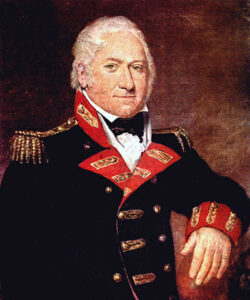 Most of us have heard of shrapnel. Shrapnel shells have been obsolete since the end of World War I for anti-personnel use, but they were “anti-personnel artillery munitions which carried many individual bullets close to a target area and then ejected them to allow them to continue along the shell’s trajectory and strike targets individually. They relied almost entirely on the shell’s velocity for their lethality.” These days, high-explosive shells are used for that role. The functioning and principles behind Shrapnel shells are fundamentally different from high-explosive shell fragmentation. Shrapnel is named for its inventor, Lieutenant-General Henry Shrapnel (1761–1842). Shrapnel was a British artillery officer, whose experiments, initially conducted on his own time and at his own expense, culminated in the design and development of a new type of artillery shell.
Most of us have heard of shrapnel. Shrapnel shells have been obsolete since the end of World War I for anti-personnel use, but they were “anti-personnel artillery munitions which carried many individual bullets close to a target area and then ejected them to allow them to continue along the shell’s trajectory and strike targets individually. They relied almost entirely on the shell’s velocity for their lethality.” These days, high-explosive shells are used for that role. The functioning and principles behind Shrapnel shells are fundamentally different from high-explosive shell fragmentation. Shrapnel is named for its inventor, Lieutenant-General Henry Shrapnel (1761–1842). Shrapnel was a British artillery officer, whose experiments, initially conducted on his own time and at his own expense, culminated in the design and development of a new type of artillery shell.
Henry Shrapnel was born June 3, 1761 at Midway Manor in Bradford-on-Avon, Wiltshire, England, the ninth child of Zachariah Shrapnel and his wife, Lydia. Shrapnel became an artillery officer and inventor of a form of artillery case shot (shrapnel). He was commissioned in the  Royal Artillery in 1779, and served in Newfoundland, Gibraltar, and the West Indies. He was wounded in Flanders in the Duke of York’s unsuccessful campaign against the French in 1793. In 1804 he became an inspector of artillery and spent several years at Woolwich arsenal.
Royal Artillery in 1779, and served in Newfoundland, Gibraltar, and the West Indies. He was wounded in Flanders in the Duke of York’s unsuccessful campaign against the French in 1793. In 1804 he became an inspector of artillery and spent several years at Woolwich arsenal.
In 1784, while a lieutenant in the Royal Artillery, he perfected, with his own resources, an invention of what he called “spherical case” ammunition: a hollow cannonball filled with lead shot that burst in mid-air. He successfully demonstrated this in 1787 at Gibraltar. He intended the device as an anti-personnel weapon. In 1803, the British Army adopted a similar, but elongated explosive shell which immediately acquired the inventor’s name. It has lent the term “shrapnel” to fragmentation from artillery shells and fragmentation in general ever since, long after it was replaced by high explosive rounds, but this usage is not the original 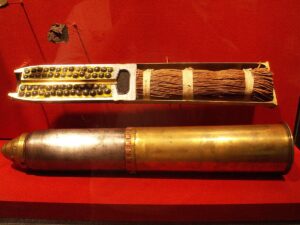 meaning of the word. Until the end of World War I, the shells were still manufactured according to his original principles.
meaning of the word. Until the end of World War I, the shells were still manufactured according to his original principles.
In 1814, the British Government recognized Shrapnel’s contribution by awarding him £1200 (UK£ 85,000 in 2021) a year for life, however, bureaucracy kept him from receiving the full benefit of this award. He was promoted to the office of Colonel-Commandant, Royal Artillery, on March 6, 1827, and to the rank of lieutenant-general on January 10, 1837. Shrapnel lived at Peartree House, near Peartree Green, Southampton from about 1835 until his death on March 13, 1842 at Southampton, Hampshire.

